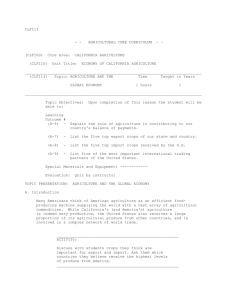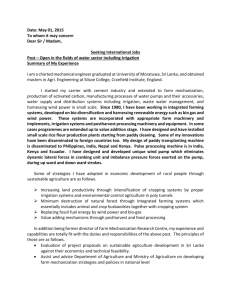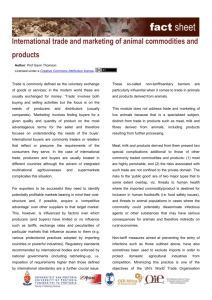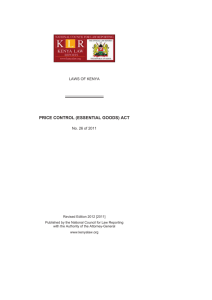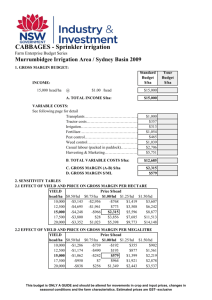The RBC Blue Water Makeover
advertisement
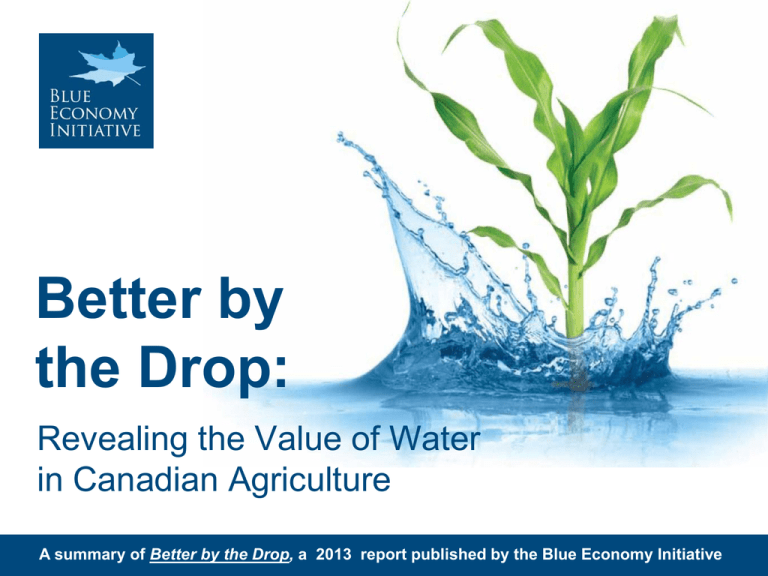
Better by the Drop: Revealing the Value of Water in Canadian Agriculture A summary of Better by the Drop, a 2013 report published by the Blue Economy Initiative FOOD FOR THOUGHT Global food demand is set to double by 2050, but the availability of fresh water is on the decline With 3,300 km3 of annually renewable water, Canada is one of only five countries in the world that can significantly expand its agricultural exports Can we unlock this economic potential by developing a strategic approach to the way we use and manage water? BEI REPORT TACKLES SOME TOUGH ISSUES Canada’s most productive food-growing regions are our driest— and getting drier. Will we be able to expand production there? Based on water availability and the economic return on “water” investment, which crops should we grow and where? Some countries target certain crops for domestic production and decide what they’ll import based on water availability. What lessons are there for Canada? Water for food, or water for fuel? What’s the global impact of this trade-off, and what role can Canada play? Which regions are getting the “crop-per-drop” ratio right? What impact would an increase in food productivity have on the long-term health of our fresh water systems? ISSUE 1: FOOD DEMAND IS ON THE RISE Population growth Changing diets, with increased demand for meat Urbanization ISSUE 2: AVAILABILITY OF CROPLAND IS SHRINKING Urban expansion Rising oceans Soil degradation Acreage used for bio-energy production rather than food These factors are sharply reducing the land area available for food production in many regions. ISSUE 3: FRESH WATER IS INCREASINGLY SCARCE Climate change Water pollution Without water, nothing can grow Groundwater overdraft These factors are curtailing fresh water availability in many of the world’s traditional ‘breadbaskets’. WHAT’S NEEDED FOR A COUNTRY TO BE A SUCCESSFUL FOOD EXPORTER? Sufficient fertile land and water Suitable climate for the key export commodities Reliable infrastructure Efficient commercial and financial services FIVE COUNTRIES HAVE WHAT IT TAKES TO FEED THE WORLD Only five countries possess the ‘Goldilocks’ combination of ample precipitation and low ratios of population to arable land: Canada Russia Brazil United States Argentina CANADA’S COMPETITIVE ADVANTAGES Water 3,300 km of annually renewable water Land Second highest ratio of arable land per capita Growing Seasons Extended seasons in parts of Canada due to warming in the continental interior and higher latitudes Infrastructure Agri-food infrastructure, well-known and well respected national identity, well-established producers and producer associations, and sophisticated intermediary sales, finance and distribution services for agricultural commodities. Canada’s transportation and shipping infrastructure is competitive with any other exporting nation. OUR TOP FOOD EXPORTS AND EXPORTING REGIONS Canada is ranked number one in global production of lentils, peas, linseed (flax seed), and rapeseed (canola), and second in oats and blueberries (as ranked by the United Nations). Agricultural production is estimated to contribute $139 billion annually to Canada’s economy In 2011, beef was the most valuable commodity in Canada, followed by rapeseed, pork, milk and chicken Canada ships more than half the peas, lentils and linseed available to other nations, and roughly a third of the world’s canola Canada exports between 56-93 per cent of its national production of key food commodities VALUE OF FOOD COMMODITIES PRODUCED IN CANADA BETWEEN 2001-2011 Source: FAO (2011) VALUE OF TOP FOOD COMMODITIES EXPORTED FROM CANADA 2001-2010 Source: FAO (2011) ON THE OTHER HAND Canada’s farm belt is getting drier The most fertile regions are most at risk We are degrading the water we have There’s a limited opportunity to grow crops in Canada's boreal region and the Canadian Shield OUR FARMLAND Provinces with irrigated agriculture: Saskatchewan Alberta British Columbia Provinces that primarily rely on rainfed agriculture: Manitoba Ontario Quebec Maritime provinces TOTAL VIRTUAL WATER REQUIREMENT British Columbia , Okanagan Valley – Irrigation water needed per year FIVE WAYS TO MAXIMIZE WATER PRODUCTIVITY 1 Improve irrigation efficiency 2 Reduce the area under irrigation 3 Grow crops that are water efficient Establish virtual water metrics 4 (the volume of water required to produce a quantity of food or any other product) 5 Distinguish between irrigated water use (blue and grey water) and rainfed production (green water) P.S ON WATER MATH Crop-per-Drop crop water required to produce it = farm product’s water efficiency Dollar-per-Drop $ crop-perdrop x market price for that crop = economic value of the virtual water TO SUM UP When water is plentiful in a growing region, a rational strategy may be to pursue the highest export dollar value regardless of a crop’s water intensity. But as water supplies become more strained, new alternatives can arise when individual farmers, irrigation districts, agri-food producers and government authorities know which farm products deliver the most ‘crop-per-drop’ under different conditions. SEVEN RECOMMENDATIONS 1 Develop drought/flood contingency plans 2 Provide incentives for innovation in water efficiency 3 Establish virtual water and water footprint analysis pilot projects 4 Create national virtual water inventory and risk assessment tool 5 Support farm level research, education and access to information 6 Implement true cost accounting to capture externalities 7 Evolve toward full water footprint/life cycle assessment SHARE OUR VISION? READ MORE Follow BEI on Twitter @ BlueEconomyca





